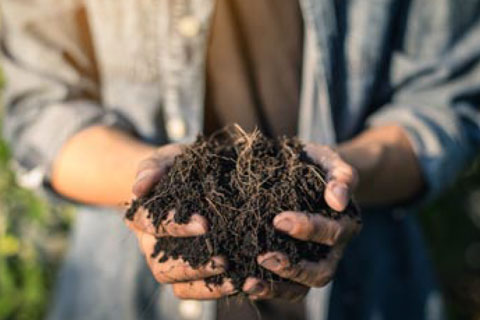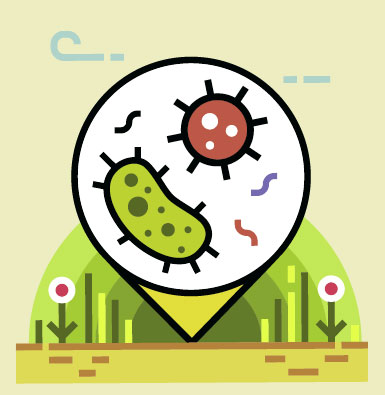8/1/2021
Spreading the Message of Healthy Soils
Ellen C. Wells

Healthy plants grow from healthy soils. As horticulture professionals we know that. But do our customers know that? Maybe our longer-term customers have an inkling about that soil/plant relationship, likely from many years of growing experience. But do those 20-odd million new gardeners understand that their plant success depends on their soil’s health? What the plants grow in is often considered just a place to park the plant in the quest for pretty flowers and plump tomatoes.
“Soil has been around for millions and millions of years,” PrescriptionSOIL Solutions owner Kip Connelly says. “We’ve become so technical in our lives today that we tend to overlook something that is tens of millions of years old. I think soil is an overlooked medium in plant growth; people tend to ignore soils because they can do so much so quickly topically. If you want to green up your [lawn] just apply something with iron or nitrogen and you immediately have color. But it’s the soil that gets affected long-term unless you analyze the soil.”
If we want customers to have long-term success in the garden, we may want to clue customers into this key component of their long-haul gardening journey that is often just bypassed.
What’s Soil Health Anyway?
Before we explore ways to communicate soils’ importance to gardening success, let’s first give “soil health” some definition. According to Joe “Joe Gardener” Lamp’l of the PBS television series “Growing a Greener World,” soil health is, “a vibrant ecosystem of the soil food web consisting of bacteria, fungi, protozoa, with all those things working together to create the nutrients, soil structure and humus that allow plants to thrive. You have to build soil health in concert with nature and science.”
Joe has a simple phrase that puts the point plainly: Feed the soil (i.e. all the characters in the food web) and let the soil feed your plants. Think of it in terms of humans for a moment. We humans have a choice of how to satisfy our hunger. We can grab a chips-and-soda snack and our hunger goes away, but those are calories and nutrition that we burn through easily. Or we can eat a more nutritious meal—some protein, some vegetable, maybe a carbohydrate—whose components contribute to the longer-term functioning of the body. Minding only the N-P-K ratios that go into the soil for the plant to use neglects the health of the food web components, the billions of bacteria, fungi and protozoa that help make nutrients available to plants.
Mark Highland, president of Organic Mechanics Soil Company, has a similar definition of soil health, but with the addition of soil characteristics: “Healthy soil contains mostly topsoil, has the appropriate level of organic matter and porosity for your region, contains abundant and diverse soil biology and serves as both an anchor for plants and as a reservoir for water, nutrients and the microbial habitat.” Soil health, therefore, becomes not just what is in addition to the soil, but also the soil—the silt, sand, clay and loam—itself.
What Customers Should Know About Soils
When it comes to what customers need to know about soil health, Mark believes the very first thing they need to understand is that soils and potting soils are not the same thing. “There are mediums that are to be used just as potting soil and there are mediums that are meant to be used just in the ground in your garden,” Marks says. “These 20 million new gardeners don’t know the difference.” Put topsoil into a container and your plant will have a hard time with drainage. It’s not an opinion. It’s physics.
Mark’s second point to drill home to customers is the fact that “the soil we walk on, that our planting beds are in—that soil is alive,” Mark says. “Yes, it’s essentially rocks, organic matter, water and air spaces, but soil is teeming with life. Good, healthy soil has a lot of biological activity that occurs naturally. Understand that that exists and when we add things to our gardens, we are either feeding soil microbes and helping them proliferate—a beneficial thing for our gardens—or we are adding the opposite, products that don’t feed the microbes, and we’re not going to get that extra benefit in our gardens.”
Kip’s message to garden centers and their customers is this: “The beauty of a soil analysis is it tells you what your soil really needs, therefore you don’t overapply anything. A healthy soil really will reduce the amount of weed killer, fungicide and fertilizer you need to apply.” That message may be appealing to customers because it saves them money in the long run.
Increasing for Soil Awareness
Joe feels that the subject of soil is important for customers to know about, but it’s also one that can be overwhelming if they are left to their own devices to figure it out. “People become so confused and so bogged down by the enormity of the information out there that they are more confused when they leave their query than when they started it,” he says. “How nice would it be if a garden center really took on the role of being that guide or that person or place to provide both the information and the product?”
Maybe the way consumers view soil should be redirected. “People want that quick solution that takes care of their immediate problem,” Joe says. “But we need to change the way they think about their gardening, moving towards building that long-term success, that sustainability and vigor and all those things that don’t come with throwing a quick fix at the problem.”
That change of thinking can start with a garden center staff that understands the importance of soil health themselves, suggests Mark. “I know a lot of garden centers have issues with spending the time to do that,” Mark explains, “but an educated team can sell without sounding like they are selling. If you understand the topic you can just casually talk to someone about it.”
Mark also believes that retail displays can be created to better inform customers about what different bags of soils and amendments can do to benefit soil health. This information is usually directly on the front of the product bags. “When bags are turned sideways on the shelves or on pallets, consumers can’t read anything except what’s on the sides,” he says. “Take the time to work the soils into the merchandising displays. Borrow ideas [from trendy retailers]. It’s not stealing. It’s being inspired.”
For Kip with PrescriptionSOIL Solutions, garden centers have an opportunity to educate customers on the importance of soil on the off-seasons, which are typically the summer and winter months when traffic for other products isn’t keeping the staff and the customers busy. “It’s feasible [to educate] if they take the off-seasons to address the soil, and ultimately it will lead the customer back to their store.” Kip suggests a campaign—could be mail, direct mail, email, social—to encourage customers to bring soil samples from their lawn or garden and have the soil’s nutrition analyzed. “That’s the service we provide at PrescriptionSOIL. We’ve built a product whereby we white-label soil kits for the garden center, they sell the store-branded kits to their customers, we produce the soil sample results at an independent lab and give instructions that are specific to that garden center’s products. That garden center monitors what the customers need to do and helps mentor them all year long to balance their soil or at least make it as healthy as possible.”
But more than about money, more than about pulling customers into the store, soil health is about caring for and working with nature’s own processes. “It’s important for every one of us—no matter where we come from or what our business model is—to pay a little more attention to Mother Earth and care for Mother Earth,” Kip reflects. “Because if we abuse Mother Earth, we will quickly find ourselves out of business.”

Microbial Magic
Here’s a refresher on that 10th-grade soil biology class you may have forgotten: Microbes that live in soil benefit the plants that grow around them in a number of different ways. Most importantly for gardening success, microbes help increase a plant’s resistance to many kinds of stress such as drought, pest and disease stressors.
Microbes also drive the nutrient cycling that occurs in soils. Organic Mechanics Soil Company President Mark Highland explains it like this: “A protozoa eats a bacteria and doesn’t need all the extra nitrogen so ejects the extra water-soluble nitrogen out of their cells,” making it available for plant roots to absorb. “It’s nutrient cycling, it’s microbes eating microbes, it’s the underground safari,” he explains. Other than increasing stressor resistance and nutrient cycling, microbes will, over time, help create a soil structure that increases moisture retention as well as nutrient retention. GP